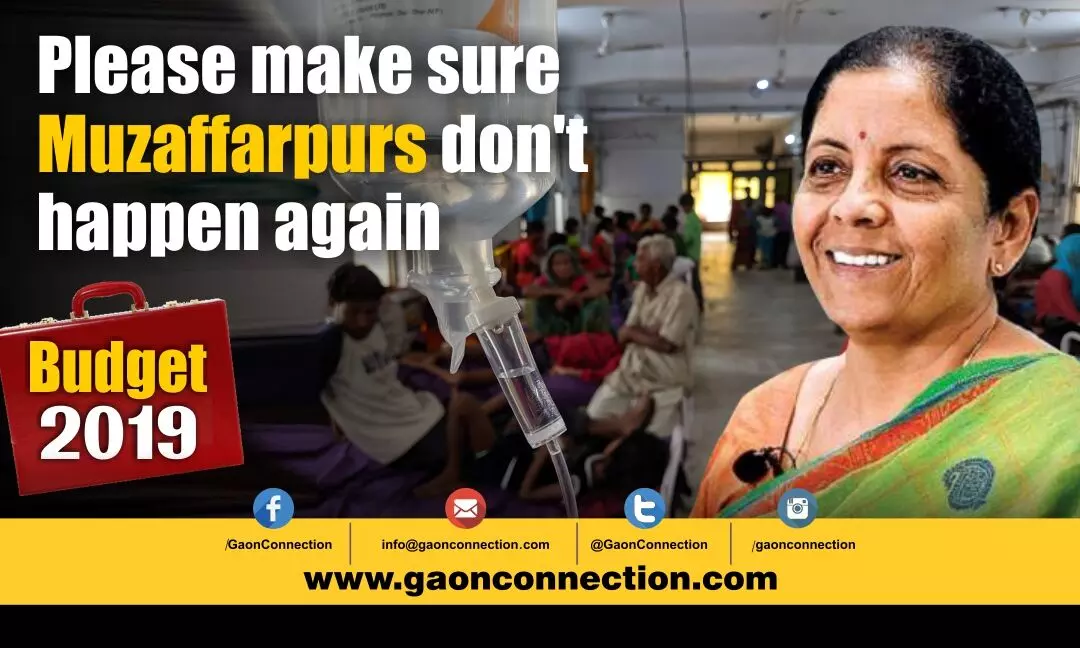It's high time we invest more in health infrastructure, doctors
An analysis of the government’s budget allocation on major items showed that India spends approximately five times more on defence than on health care. India’s defence allocation this year (2019-2020) is Rs 2,82,733 crore and health allocation is Rs 63,538 crore. The defence budget thus is 4.8 times the health budget. In fact, in the interim budget, out of the 27 major items of expenditure, health got the 14th largest funding this year at Rs 63,538 crore. This needs to change
 Chandrakant Mishra 4 July 2019 12:34 PM GMT
Chandrakant Mishra 4 July 2019 12:34 PM GMT

As part of the Interim Budget 2019, the Narendra Modi government had in February announced a 16.65% increase in its allocation for the health sector.
The Modi government's flagship healthcare initiative -- the Pradhan Mantri Jan Arogya Yojana (PMJAY), widely referred to as 'Ayushman Bharat' -- received an allocation of Rs 6,400 crore, which is an increase of Rs 4,000 crore.
Delivering the Budget speech in Lok Sabha in the place of Arun Jaitley, Piyush Goyal said around 10 lakh people have so far availed of free treatment under Ayushman Bharat. The total cost of their treatment was estimated at Rs 3,000 crore.
The fact, however, is that in India Defence accounts for 11% of India's overall expenditures and health accounts for 2%.
An analysis of the government's budget allocation on major items showed that India spends approximately five times more on defence than on health care. India's defence allocation this year (2019-2020) is Rs 2,82,733 crore and health allocation is Rs 63,538 crore. The defence budget thus is 4.8 times the health budget. In fact, in the interim budget, out of the 27 major items of expenditure, health got the 14th largest funding this year at Rs 63,538 crore.
Dismal track record
According to the World Health Organisation, 3.9% of our total population -- 5.1 crore Indians -- spend one-fourth of their household budget on health. In Sri Lanka this figure stands at 0.1%, in Britain 0.5%, in America 0.8% and in China 4.8%.
Though India's expenditure on the health sector has risen from 1.2% of the GDP in 2013-14 to 1.4% in 2017-18, but it's a negligible increase.
"The government should spend at least 5-6% the GDP on healthcare. It should improve resources at government hospitals, especially in rural India," said Dr Sandip Tiwari, in-charge of trauma centre at King George Medical University, Lucknow.
Just a month back nearly 130 people died due to suspected Acute Encephalitis Syndrome (AES) and around 400 cases of AES were reported. Many parents feel that their children died because of doctor's negligence and poor facilities, especially at Primary Health Centres (PHCs) and Community Health Centres (CHCs) -- which are the first rung in any states' healthcare system.
Prof Rajendra Prasad, ex director of Patel Chest Institute, New Delhi, said: "We keep talking about how pathetic healthcare facilities in India are and we also keep making policies, but when it comes to implementation, we fail. A large part of our population suffers because of this. Take for instance TB. It can now be cured but still so many people succumb to this disease. It's high time that authorities take healthcare very seriously."
Many families below the poverty line
According to National Health Profile, every fourth family in India has to take loan or sell their land when someone in the family falls sick. As a result of this, almost 7% India's slip below the poverty line and they then can't avail the benefits of Ayushman Bharat scheme. Twenty-three per cent people can't even afford to avail healthcare facilities owing to poverty.
According to a World Bank report, in India people spend 68% from their own pocket on healthcare, whereas across the world this average is 18%.
Since facilities at government hospitals are so poor, people are forced to go to private hospitals.
Arun Shah, a paediatrician who practices in Muzaffarnagar, Bihar said: "The situation if quite grim in rural areas. Major hospitals or government hospitals are in big cities. The Public Health Centres and Community Health Centres are not equipped to deal with patients. They never have enough staff and medicines. It's sad but people in villages don't go to these doctors but they prefer going to quacks, which makes them more sick."
There are many hospitals, fewer doctors
What makes the situation worse is that there are more hospitals than doctors. "The government is opening new hospitals and is not making any attempt to increase number of doctors and nurses. Who is going to treat patients?" asks Dr Narayan Prasad, who works in the nephrology department at Sanjay Gandhi Postgraduate Institute of Medical Science, Lucknow.
Padma Shri Dr NK Pandey had said in an interview once, "World over, countries spend almost 6% of their GDP on healthcare. But in India, we don't spend even 2%. The Ayushman Bharat scheme is a lifeline for poor, but it has not reached many interior areas."
The government will unveil its annual budget for the 2019-20 fiscal year on July 5, 2019 and people are longing for improved healthcare.
Indians are hoping that the Narendra Modi-led government will take a step forward to advance the 'promised' healthcare facilities in India. The interim budget did not prominently focus on the government's flagship scheme, National Health Mission as it received only a marginal increase of Rs 1,600 crore against Rs 1,400 crore in 2018-19.
More Stories




